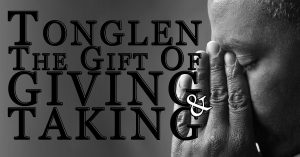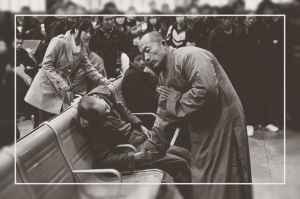The gift of giving and receiving
Tonglen: How to awaken compassion
 There is no denying that we live in a world where the dominant discourse is suffering. What’s more is if we allow it to be, suffering will remain the prominent narrative of our lives, creating a life of simple survival. Yet, if we actively seek and choose to make change to this discourse within our spirit, to awaken compassion through the process of Tonglen, suffering can actually be the catalyst to change.
There is no denying that we live in a world where the dominant discourse is suffering. What’s more is if we allow it to be, suffering will remain the prominent narrative of our lives, creating a life of simple survival. Yet, if we actively seek and choose to make change to this discourse within our spirit, to awaken compassion through the process of Tonglen, suffering can actually be the catalyst to change.
The sorrow within us is reflective of all sentient suffering: this is the paradox of pain. Through sensation and perception of life events, we evoke emotions within us that are an expression of our unique energy. Emotions based in our inimitable energies of fear create our suffering. Further, it is indeed imperative to understand that all beings experience parallel expressions of their own unique energy that encapsulates a vast history of pain and suffering.
Knowing of the paradox of pain, we may ask – what does this mean for me?
Knowing that our suffering is others suffering allows us to tap into the immeasurable value of compassion – the practice of loving kindness that sets those on a path to enlightenment apart from those content in self-perpetuated sorrow.
Tonglen is the practice of connecting with suffering to diminish our need of earthly connection and self-cherishing wants and acts. When we remember that all actions come from the motivation of our hearts, we begin to understand that unless we tap into our subconscious motivations we are unable to change action, and thus unable to change our path toward enlightenment. As suffering is innate and often a part of our very identity, the importance of practices that bring the unconscious suffering, or perhaps the unconscious blockages that keep our energies from achieving balance, are imperative.
When unconscious or perhaps “trapped”, suffering may lead to states of body and mind inflammation and disintegration– which is the basis of the scientific cyclic continuum of disease (Kiecolt-Glaser, Derry, Fagundes, 2015). Furthermore, when looking though the window of science there has been many studies, theories, and practices derived from the Buddhist tradition of meditation, specifically loving kindness meditations and spiritual awareness. This indicates that indeed practices of compassion such as Tonglen have the capacity to unlock the blockages of our energies (Benefits and references discussed below).
Okay, so what does Tonglen look like? How do I awaken compassion?
 The basis of Tonglen is the premise of giving and receiving: the giving of love and kindness, and the receiving of others suffering in order to remove it from them. Although this may seem like a practice that may remove our own energy stores (Karma), once again this is the paradox of pain: In understanding, and indeed “feeling” one another’s pain, a quality of connectedness of the energies within and between brings about self regulatory and present moment curiosity, openness, and acceptance (Hofmann, Grossman, and Hinton, 2011). Meaning by giving and receiving, we are “affectually” broadening our own karma.
The basis of Tonglen is the premise of giving and receiving: the giving of love and kindness, and the receiving of others suffering in order to remove it from them. Although this may seem like a practice that may remove our own energy stores (Karma), once again this is the paradox of pain: In understanding, and indeed “feeling” one another’s pain, a quality of connectedness of the energies within and between brings about self regulatory and present moment curiosity, openness, and acceptance (Hofmann, Grossman, and Hinton, 2011). Meaning by giving and receiving, we are “affectually” broadening our own karma.
The practice, as per The Seven Points of Mind Training By The Venerable Khenchen Thrangu Rinpoche Geshe Lharampa, involves
… imagining other living beings in front of us, many or just a few. We can imagine people in pain, people we know who are sick, people in distress or suffering. We imagine that we send these people happiness and the causes of happiness as well. For this to happen, we imagine that we give them whatever goodness we can think of, and we imagine that we receive whatever suffering and causes of suffering, all the distress and negative emotions they experience. We imagine that by being freed from suffering and its causes, they experience happiness and well-being. We practice this again and again and thus become more and more used to taking away the suffering of others and giving them our own well-being and causes of happiness. By training in this sending and taking practice, the regarding of oneself as more important than others diminishes and regarding others as more important becomes stronger and stronger…
Finally, in Tonglen, universal connectedness is cultivated through active compassion, one of the more skilful means of purification of mind. Therefore, it is common in this practice to meet our own suffering. That is, in the process of breathing in the darkness of others, we may stumble across a hesitation that opens us to the subconscious realm of our own suffering. This is the unique invitation of Tonglen. When we are receiving the suffering of others, we feel the reality of our own impermanence and immortality, thus bringing to consciousness our own dark energies of suffering. If we can learn to non-judgmentally notice, allow, and accept our own suffering as it relates to others, we can align compassion to self with other, which in turn allows for pain to be alleviated in connectedness. Certainly, Tonglen is a practice worth cultivating into our daily lives.
Tell me more about the scientific benefits of Tonglen…
There are a multitude of empirical studies validating the effectiveness of compassion meditation as both intervention and prevention in health and general wellbeing (for example Dalh, Lutz, and Davidson, 2016; Virtbauer, 2015; Hofmann, Grossman, and Hinton, 2011; Dein & Littlewood, 2008; Kang, Gray, Dovidio, 2014; Galante, Galante, Bekkers, & Gallacher, 2014; Lo, 2013; Stellar, Cohen, Oveis, & Keltner, 2015; ). Moreover, when delving into the realms of specific forms of spirituality and meditation practices, one stumbles across a plethora of literature and media, some scientifically validated, some not, linking wellbeing to spirituality and the cultivation of a broader sense of universal awareness and significance. Nonetheless, the empirically tried and tested benefits of meditative practices of compassion or loving kindness for others, such as Tonglen include, yet seem not to be limited to:
- Regulation of cognitive functioning
- Reduction of negative psychological states, such as stress, anxiety, and depression
- Increase of personal resources that hold positive consequences for the person’s mental health
- Lower affect of pain, anger, and psychological distress to a greater degree than standard care (in chronically ill patients)
- Moderator of the effect of stress on immune and neuroendocrine responses
- Improvement in neurological integration and sense making processes
- Relaxation, increased self -esteem, and provision of optimism
- Improvement of automatically activated, implicit attitudes toward stigmatized social groups
- Vagas Nerve stimulation or heightened parasympathetic activity
- Formation of new neuro pathways that generate automatically activated compassion toward all sentient suffering.
Furthermore, and perhaps more astoundingly, the “powers of prayer” have been linked to excessive stimulation of the limbic system, combined with the switching off and on of the frontal lobe (concentration) and parietal regions (spatial, visual, and sensory input). This creates a scientific representation of a brain that uses energy in a manner that allows focused attention to remove preconceived perceptions and learned ideals of space and time, and to simply connected with the universal energies (Shukla, Acharya, & Rajput, 2013). Indeed, as Shukla, Acharya, and Rajput (2013) state:
…when it comes to extraordinary beliefs, phenomena, unimaginable feats and emotional deviations of the human mind, especially those which involve deep faiths and beliefs, comprehensive neuroscientific explanations from the emerging data, with the aid of elaborate neuroimaging, have proved to be extremely rational and logical.
 Meaning, although the evidence cannot actually make complete sense of consciousness and subconsciousness, due mostly to the inconsistency in definitions of consciousness, it can make logical sense that the non physical entity that is the mind is actually: “an embodied and relational, self-organising emergent process that regulates the flow of energy and information both within and between” (Siegel, 2017, p. 37).
Meaning, although the evidence cannot actually make complete sense of consciousness and subconsciousness, due mostly to the inconsistency in definitions of consciousness, it can make logical sense that the non physical entity that is the mind is actually: “an embodied and relational, self-organising emergent process that regulates the flow of energy and information both within and between” (Siegel, 2017, p. 37).
These two notions together (along with quantum physics) allows us to somewhat fathom (if you can), that space and time are manipulate-able entities that can literally allow us to, as has been practised in Toglen for centauries, receive others suffering, and to give loving kindness.
Or as Dr Dan Siegel (2017) relates:
… [The biology of compassion is] how we see the mind as beyond the activity of the brain, how subjective experience may arise from our neural firing but is not the same as neuronal activity, how the mind may also have an emergent process of self-organisation, and that this process is both embodied and relational. In seeing integration as the basis for health, we could then sense how the embodied and relational mind moves towards integration in the process of cultivating well-being. One fundamental expression of that integration is compassion and kindness. (pp. 189-190; emphasis added)
And, although the science for meditation and prayer may be fraught with questions perhaps the gift of giving and receiving, and the practice if Tonglen, simply brings a deeper level of understanding of sentient suffering, the paradox of pain, and the imperative nature of connectedness.
If you are interested in cultivating presence among others, a more formal class setting or retreat may be more encouraging. At Celia Roberts Retreat in Brookfield, Qld, we offer meditation retreats throughout the year enabling you to experience and to learn how to cultivate presence in the company of a senior teacher



